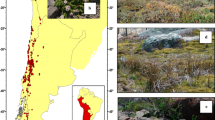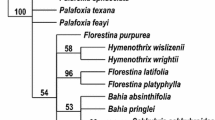Abstract
The Cape Floristic Region and the Succulent Karoo in southwestern Africa are both noted for their plant species richness and high levels of endemism. The southwestern tip of Africa is one of the world's five Mediterranean-type climate regions. The biodiversity in the Cape Floristic Region and Succulent Karoo is thought to be at least partly due to changes to the climate of these regions that have occurred since the middle Miocene. Annual species are usually a significant proportion of local flora in Mediterranean-type climate regions. Previous studies of species radiations in the Cape Floristic Region have concentrated on genera that predominantly contain perennial species. Nemesia (Scrophulariaceae) comprises c. 65 species of annual and perennial herbs and sub-shrubs that are native to southern and tropical Africa. Annuals make up a significant proportion (~75%) of Nemesia species. We have reconstructed a phylogeny of 23 Nemesia species using nucleotide sequences of the ITS, ETS and trnL-spacer regions. Species were grouped into five clades, two composed of annual species, one that contained two annual and one perennial species, one that contained one annual and two perennial species, and one that was predominantly composed of perennial species. Phylogenetic dating of the ITS + ETS based phylogenetic tree using penalised likelihood suggested the genus evolved during the Miocene, and that the majority of extant Nemesia species studied radiated during the Pliocene. Ancestral state reconstruction supports at least three separate origins of the annual habit from plants with a perennial life history. One origin can be traced to the late Miocene while the other two transitions occurred more recently during the Pliocene. The transition from perennial to annual life-histories in Nemesia may have been a response to climate change.
Similar content being viewed by others
References
Albach DC, Meudt H, Oxelman B (2005) Piecing together the “new” Plantaginaceae. Amer J Bot 92: 297–315
Andreasen K, Baldwin BG (2001) Unequal evolutionary rates between annual and perennial lineages of checker mallows Sidalcea, (Malvaceae): Evidence from 18S–26S rDNA internal and external transcribed spacers. Molec Biol Evol 18: 936–944
Angiosperm Phylogeny Group [APG II] (2003) An update of the Angiosperm Phylogeny Group classification for the orders and families of flowering plants: APG II. Bot J Linn Soc 141: 399–436
Bakker FT, Culham A, Hettiarachi P, Touloumenidou T, Gibby M (2004) Phylogeny of Pelargonium (Geraniaceae) based on DNA sequences of three genomes. Taxon 53: 17–28
Baldwin BG, Sanderson MJ, Porter JM, Wojciechowski MF, Campbell CS, Donoghue MJ (1995) The ITS region of nuclear ribosomal DNA: a valuable source of evidence on angiosperm phylogeny. Ann Missouri Bot Gard 82: 247–277
Baldwin BG, Sanderson MJ (1998) Age and rate of diversification of the Hawaiian silversword alliance (Compositae). Proc Natl Acad Sci U.S.A. 95: 9402–9406
Bamford M (1999) Pliocene fossil woods from an early hominid cave deposit, Sterkfontein, South Africa. S. African J Sci 95: 231–237
Barry RG, Chorley RJ (1992) Atmosphere, Weather and Climate. Routledge, London
Bremer K (2002) Gondwanan evolution of the grass alliance of families (Poales). Evolution 56:1374–1387
Bremer K., Friis EM, Bremer B (2004) Molecular phylogenetic dating of asterid flowering plants shows Early Cretaceous diversification. Syst Biol 53: 496–505
Buckler ES IV, Ippolito A, Holtsford TP (1997) The evolution of ribosomal DNA: divergent paralogues and phylogenetic implications. Genetics 145: 821–832
Church SA (2003) Molecular phylogenetics of Houstonia (Rubiaceae): descending aneuploidy and breeding system evolution in the radiation of the lineage across North America. Molec Phylogenetics Evol 27: 223–238
Coetzee JA (1993) African flora since the terminal Jurassic. In: Goldblatt P (ed) Biological Relationships between Africa and South America. Yale University Press, New Haven, Connecticut, pp 37–61
Corpet F (1988) Multiple sequence alignment with hierarchical clustering. Nucl Acids Res 16: 10881–10890
Cowling RM, Rundel PW, Lamont BB, Arroyo MT, Arianoutsou M (1996) Plant diversity in mediterranean-climate regions. Trends Ecol Evol 11: 362–366
Felsenstein J (1981) Evolutionary trees from DNA sequences: a maximum likelihood approach. J Molec Evol 17: 368–376
Felsenstein J (1985) Confidence limits on phylogenies: an approach using the bootstrap. Evolution 39: 783–791
Fiz O, Valcárcel V, Vargas P (2002) Phylogenetic position of Mediterranean Astereae and character evolution of daisies (Bellis. Asteraceae) inferred from nrDNA ITS sequences. Molec Phylogenet Evol 25: 157–171
Goldblatt P (1978) An analysis of the flora of southern Africa: its characteristics, relationships and origins. Ann Missouri Bot Gard 65: 369–436
Goldblatt P, Manning JC (2002) Plant diversity of the Cape region of Southern Africa. Ann Missouri Bot Gard 89: 281–302
Goldblatt P, Savolainen V, Porteous O, Sostaric I, Powell M, Reeves G, Manning JC, Barraclough TG, Chase MW (2002) Radiation in the Cape flora and the phylogeny of peacock irises Moraea (Iridaceae) based on four plastid DNA regions. Molec Phylogenet Evol 25: 341–360
Hendey QB (1982) Langebaanweg. A record of past life. South African Museum, Cape Town
Hiern WP (1904) Scrophulariaceae. In: Thistleton-Dyer WT (ed), Flora Capensis 4(2), 1–420. Reeve and Co., London
Hilliard OM, Burtt BL (1984) A revision of Diascia section Racemosae. Jl of S Afr Bot 50: 269–340
Hilliard OM, Burtt BL (1986) Notes on some plants of southern Africa chiefly from Natal: XIII. Notes Roy Bot Gard Edinburgh 43: 345–405
Huelsenbeck JP, Hillis DM, Nielsen. R (1996) A likelihood-ratio test of monophyly. Syst Biol 45: 546–558
Linder HP (2005) Evolution of diversity: the Cape flora. Trends in Plant Sci 10: 536–541
Linder HP, Hardy CR. (2004) Evolution of the species-rich Cape flora. Phil Trans Roy Soc London, Ser B, Biol Sci 359: 1623–1632
Maddison WP, Maddison DR (1992) MacClade: Analysis of Phylogeny and Character Evolution. Version 3.0. Sinauer Associates, Sunderland, Massachusetts
McCarthy C (1998) Chromas 1.45 Free program available at: http://www.technelysium.com.au/chromas.html
Magallón S, Crane PR, Herendeen PS (1999) Phylogenetic pattern, diversity, and diversification of eudicots. Ann Missouri Bot Gard 86: 297–372
Mummenhoff K, Al-Shehbaz IA, Bakker FT, Linder HP, Mühlhausen A (2005) Phylogeny, morphological evolution, and speciation of endemic Brassicaceae genera in the Cape flora of Southern Africa. Ann Missouri BotGard 92: 400–424
Oxelman B, Kornhall P, Olmstead RG, Bremer B (2005) Further disintegration of Scrophulariaceae. Taxon 54: 411–425
Pagel M (1994) Detecting correlated evolution on phylogenies: a general method for the comparative analysis of discrete characters. Proc Roy Soc London, Ser B, Biol Sci 255: 37–45
Pagel M (1999) The maximum likelihood approach to reconstructing ancestral character states of discrete characters on phylogenies. Syst Biol 48: 612–622
Posada D, Crandall KA (1998) MODELTEST: testing the model of DNA substitution. Bioinformatics 14: 817–818
Richardson JE, Weitz FM, Fay MF, Cronk QCB, Linder HP, Reeves G, Chase MW (2001a) Phylogenetic analysis of Phylica L. (Rhamnaceae) with an emphasis on island species: evidence from plastid trnL-F and nuclear internal transcribed spacer (ribosomal) DNA sequences. Taxon 50: 405–427
Richardson JE, Weitz FM, Fay MF, Cronk QCB, Linder HP, Reeves G, Chase MW (2001b) Rapid and recent origin of species richness in the Cape flora of South Africa. Nature 412: 181–183
Robert C, Diester-Haass L, Paturel J (2005) Clay mineral assemblages, siliciclastic input and paleoproductivity at ODP Site 1085 off southwest Africa: A late Miocene-early Pliocene history of Orange River discharges and Benguela current activity, and their relation to global sea level change. Marine Geology 216: 221–238
Rønsted N, Chase MW, Albach DC, Bello MA (2002) Phylogenetic relationships within Plantago (Plantaginaceae): evidence from nuclear ribosomal ITS and plastid trnL-F sequence data. Bot J Linn Soc 139: 323–338
Sanderson MJ (2002) Estimating absolute rates of molecular evolution and divergence times: a penalized likelihood approach. Molec Biol Evol 19:101–109
Sanderson MJ (2003) R8s: inferring absolute rates of molecular evolution and divergence times in the absence of a molecular clock. Bioinformatics 19: 301–302
Sang T, Crawford DJ, Kim S-C, Stuessy TFs (1994) Radiation of the endemic genus Dendroseris (Asteraceae) on the Juan Fernandez Islands: Evidence from sequences of the ITS regions of nuclear ribosomal DNA. Amer J Bot 81: 1494–1501
Sang T, Crawford DJ, Stuessy TF, Silva OM (1995) ITS sequences and phylogeny of the genus Robinsonia (Asteraceae). Syst Bot 20: 55–64
Siesser WG (1978) Aridification of the Namib Desert: evidence from oceanic cores. In: van Zinderen Bakker EM (eds) Antarctic Glacial History and World Palaeoenvironments. Balkema, Rotterdam, pp. 105–113
Siesser WG (1980) Late Miocene origin of the Benguela upswelling system off northern Namibia. Science 208: 283–285
Silvertown J, Charlesworth D (2001) Introduction to Plant Population Biology. 4th ed. Blackwell Science Ltd., Oxford, U.K
Steiner KE (1996) Chromosome numbers and relationships in tribe Hemimerideae (Scrophulariaceae). Syst Bot 21: 63–76
Swofford DL (1998) PAUP* 4.0 - Phylogenetic Analysis Using Parsimony (*and Other Methods). Sinauer Associates, Sunderland, Massachusetts
Taberlet P, Gielly L, Pautou G, Bouvet J (1991) Universal primers for amplification of three non-coding regions of chloroplast DNA. Pl Molec Biol 17: 1105–1109
van Wyk AE, Smith GF (2001) Regions of floristic endemism in southern Africa: A review with emphasis on succulents. Umdaus Press, Pretoria
Vargas P, Morton CM, Jury SL (1999) Biogeographic patterns in Mediterranean and Macaronesian species of Saxifraga (Saxifragaceae) inferred from phylogenetic analyses of ITS sequences. Amer J Bot 86: 724–734
Verboom GA, Linder HP, Stock WD (2003) Phylogenetics of the grass genus Ehrharta: Evidence for radiation in the summer-arid zone of the South African Cape. Evolution 57: 1008–1021
White TJ, Bruns T, Lee S, Taylor JW (1990) Amplification and direct sequencing of fungal ribosomal RNA genes for phylogenetics. In: Innis MA, Gelfand DH, Sninsky JJ, White TJ (eds) PCR Protocols: A Guide to Methods and Applications. Academic Press, New York, pp. 315–322
Wikström N, Savolainen V, Chase MW (2001) Evolution of the angiosperms: calibrating the family tree. Proc Roy Soc London, Ser B, Biol Sci 268: 2211–2220
Wojciechowski MF, Sanderson MJ, Hu J-M (1999) Evidence on the monophyly of Astragalus (Fabaceae) and its major subgroups based on nuclear ribosomal DNA ITS and chloroplast DNA trnL intron data. Syst Bot 24: 409–437
Wright SD, Yong CG, Wichman SR, Dawson JW, Gardner RC (2001) Stepping stones to Hawaii: a trans-equatorial dispersal pathway for Metrosideros (Myrtaceae) inferred from nrDNA (ITS+ETS). J Biogeogr 28: 769–774
Author information
Authors and Affiliations
Corresponding author
Rights and permissions
About this article
Cite this article
Datson, P.M., Murray, B.G. & Steiner, K.E. Climate and the evolution of annual/perennial life-histories in Nemesia (Scrophulariaceae). Plant Syst Evol 270, 39–57 (2008). https://doi.org/10.1007/s00606-007-0612-4
Received:
Accepted:
Published:
Issue Date:
DOI: https://doi.org/10.1007/s00606-007-0612-4




